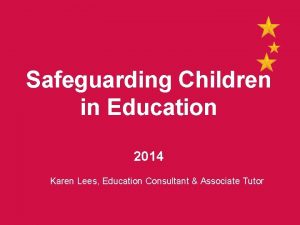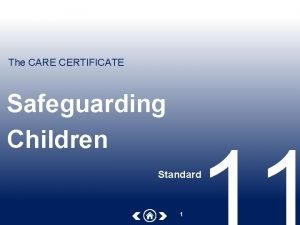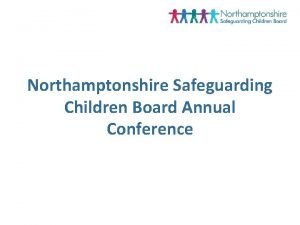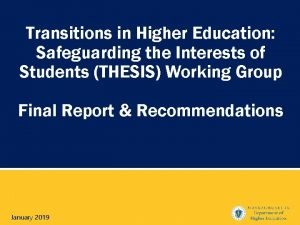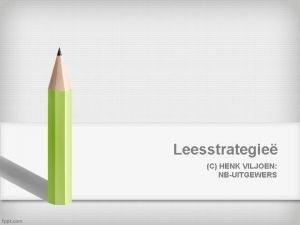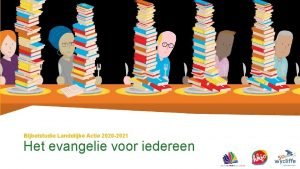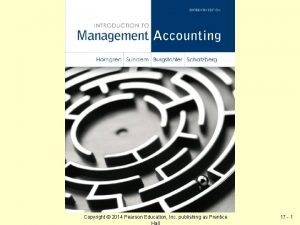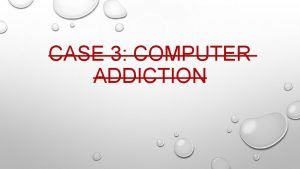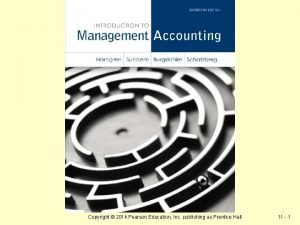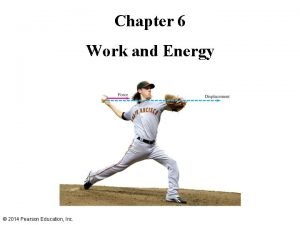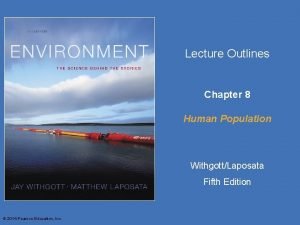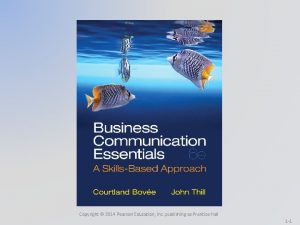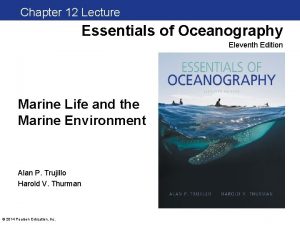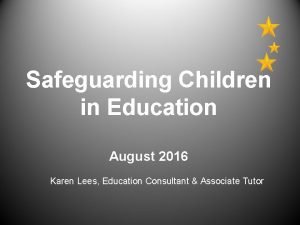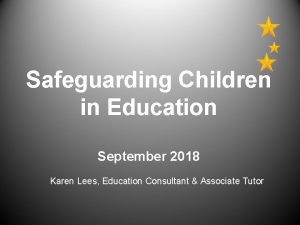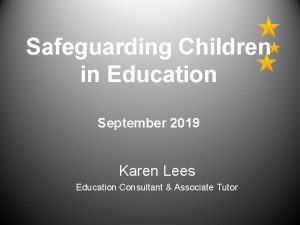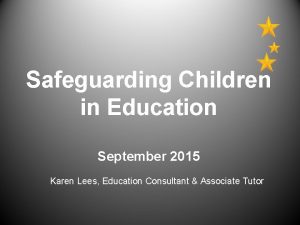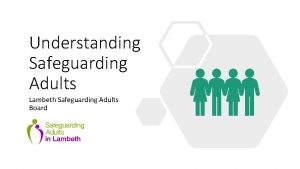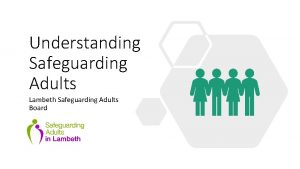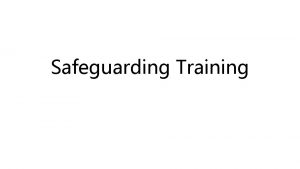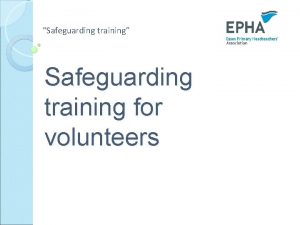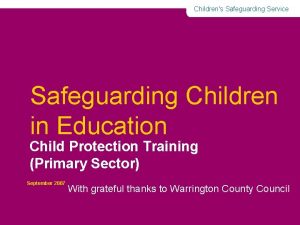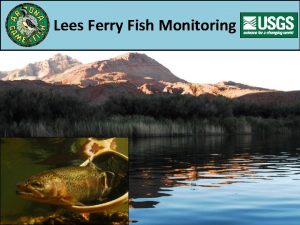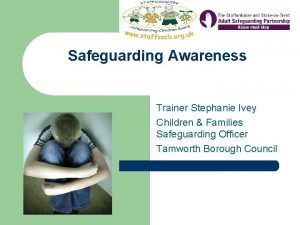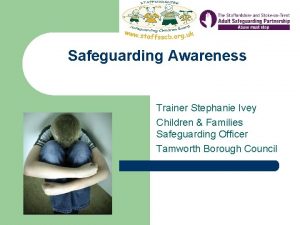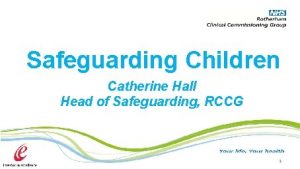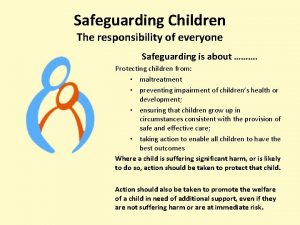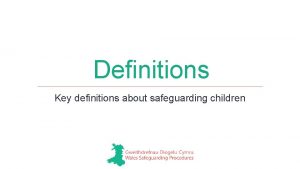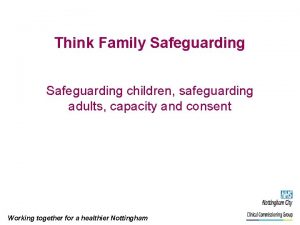Safeguarding Children in Education 2014 Karen Lees Education
































- Slides: 32

Safeguarding Children in Education 2014 Karen Lees, Education Consultant & Associate Tutor

What would you do? 1. A child tells you they have been hurt, but asks you not to tell anyone else. What do you say to this young person? 2. A parent informs you that they have been involved in a domestic incident where they and their child were hurt, but this has now been sorted out and is no longer a problem. What is your next step? 3. You have made a referral to a colleague in school but have not heard anything back from them. What, if anything, should you do? 4. A 12 year old tells you that a friend’s black eye was caused by her dad hitting her and not an accident as she had told the teacher. Do you speak to the child? 2

AIMS OF THE COURSE • To identify key pieces of legislation and guidance underpinning safeguarding children in education. • To build a basic understanding of child protection matters likely to be encountered by adults in schools. • To inform staff about what to do if they have concerns about children that relate to child protection matters. • To identify situations in which adults in schools might be vulnerable and discuss possible strategies to minimise the potential risks. 3

WHAT IS SAFEGUARDING? DEFINITION: • All agencies working with children, young people and their families take all reasonable measures to ensure that the risks to harm to children’s welfare minimised; and • Where there are concerns about children and young people’s welfare, all agencies take all appropriate actions to address those concerns, working to locally agreed policies and procedures in full partnership with other agencies. 4

CHILD PROTECTION NETWORK 5

FACTS AND FIGURES • 31% bullied during childhood • 7% seriously physically abused by their parents during childhood • 1% sexually abused by a parent or carer during childhood • 3% sexually abused by another adult during childhood. • On average one child is killed by their parent or carer every week in England Wales. (Coleman, K et al 2007) 6

Anti Bullying Policies Child Protection Attendance Behaviour Management Staff Conduct Curriculum Managing Allegations Against Staff Safeguarding Whistleblowing Building Design Health & Safety Safe Recruitment and Selection 7

Lauren Wright • When she died, she had lost four stone and weighed just two stone. • Lauren often appeared with bruises which were explained away. • Lauren was killed by her step mother. What do you think about the facts here? 8

WHAT WENT WRONG? • Lauren’s class teacher had not received child protection training • The Designated Teacher had left the school • A Governor offered to take on the role • Lauren’s stepmother told the paediatrician that the bruising was the result of Lauren being bullied at school. • No referral was made by either of the teachers • 9

A NEW DUTY AND A NEW GUIDANCE • Section 175 of the Education Act 2002 came into force in June 2004. – Creates an explicit duty to strengthen arrangements for safeguarding children. 10

‘Keeping Children Safe in Education’ Statutory guidance for schools and colleges Df. E April 2014 • This is statutory guidance from the Department for Education issued under Section 175, Education Act 2002. Schools must have regard to it when carrying out their duties to safeguard and promote the welfare of children. • Contains information about what schools should do and sets out the legal duties with which schools must comply. It should be read alongside ‘Working Together to Safeguard Children 2013’. • This guide replaces ‘Safeguarding Children Recruitment in Education’ (December 2006) 11 and Safer

Shared Objective: • Provide a safe environment for children and young people to learn in education setting. • Identify children and young people who are suffering or likely to suffer significant harm and take action with the aim of keeping them safe. 12

WHAT IS CHILD ABUSE? “Suffering, or being at risk of suffering significant harm, where harm means ill-treatment or the impairment of health or development”. Children Act 1989 • A person may abuse or neglect a child by inflicting harm or by failing to prevent harm. Children and young people may be abused in a family or in an institutional or community setting; by those known to them or, more rarely, by a stranger. 13

CATEGORIES OF ABUSE • Physical • Neglect • Emotional • Sexual 14 Often interlinked

NEGLECT Neglect is the persistent failure to meet a child’s basic physical and psychological needs, likely to result in the serious impairment of the child’s health or development. • • Failing to provide adequate food, clothing and shelter. Failure to protect a child from physical harm or danger. Failing to ensure access to appropriate medical care or treatment. Neglect of, or unresponsiveness to, a child’s basic emotional needs. • Tired, listless. • Unkempt appearance. • Poor personal hygiene. • Untreated medical conditions • Hungry or over-eats when food available. • Poor growth. • Poor or late attendance at school. 15

EMOTIONAL ABUSE Is the persistent emotional ill-treatment of a child such as to cause severe and persistent adverse effects on the child’s emotional development. • • • Persistently withholding love & affection. Constantly shouting at, threatening, or demeaning the child. Persistently being over-protective. Racial or other harassment that undermines the child’s self-esteem. Regularly humiliating a child, threatening to send them away from home or tell them their parents wish they were never born. Indicators: • Excessively clingy. Attention seeking behaviour. Low self-esteem. Apathy. Fearful or withdrawn. Constantly seek to please. Be over-ready to relate to anyone, even strangers. Depression. Regressive behaviour. Sleep disorders. Compliant and passive or aggressive and demanding. Neurotic behaviours e. g. Rocking, hair twisting. Self-harming behaviours. Drink, drugs or solvent abuse. 16

PHYSICAL ABUSE Hitting Burning Shaking Scalding Throwing Drowning Poisoning Suffocating Bite marks Illness induced/Fabricated Illness 17

PHYSICAL ABUSE 18

PHYSICAL ABUSE There can never be a definitive list of indicators • • • Unexplained injuries Injuries on certain areas of the body Regular patterning Injuries in various stages of healing Reflecting shape of article used Multiple or spiral fractures Reluctant to change for PE lessons Rebelliousness in adolescence. Behavioural extremes. Regresses to childlike behaviour. Apathy. 19 • • • Flinching when approached or touched Wary of adult contact Difficult to comfort Apprehension when others cry Crying / irritability Afraid to go home Depression. Poor peer relationships. Panics in response to pain.

SEXUAL ABUSE • Involves forcing or enticing a child or young person to take part in sexual activities, whether or not the child is aware of what is happening. May involve: - • Inappropriate touching, Inappropriate behaviours, Looking at pictures or videos, Being coerced to behave in sexually inappropriate ways. Indicators: • • • Age inappropriate sexual behaviour or knowledge. Promiscuity. Sudden changes in behaviour & mood swings. Running away from home. Wary of adults. • Feeling different from other children / young people. Poor peer relationships. • Eating disorders. • Self-harm. • Night terrors • Depression. • Unexplained gifts or money 20

WHAT STOPS CHILDREN TELLING? • • 21 Direct threats. Fear. Guilt and shame. Awareness of possible implications. Silence protects others. Lack of appropriate vocabulary. May not recognise abusive experience as abuse. May love the abuser and feel they are special. Lack of opportunity to be heard.

Golden Rules DO • Listen carefully • Clarify the facts • Make accurate notes using the child’s words • Inform the designated person for child protection • Tell the child that they have done the right thing by telling you 22 DON’T • Ask leading questions • Use your own words to describe events • Investigate • Promise confidentiality

Where can we go for more information? Your place of training will have a named person for Safeguarding and your tutors/mentor(s) will also be able to advise you In school speak to the DSP, read information, policies, etc. And each local authority has a Local Safeguarding Children Board (LSCB) 23

Where can we go for more information? Cambridgeshire Local Safeguarding Children Board www. cambslscb. org. uk Hertfordshire Safeguarding Children Board (HSCB) www. hertssafeguarding. org. uk Suffolk Safeguarding Children Board www. Suffolk. gov. uk/ Care. And. Health/Children. And. Families/Suffolk. Sa feguarding. Children. Board. htm Bedfordshire Local Safeguarding Children Board www. bedfordshirelscb. org. uk Essex Safeguarding Children Board (ESCB) www. escb. gov. uk Peterborough Local Safeguarding Children Board (PSCB) www. peterboroughlscb. org. uk 24

ACTIONS INTERPRETED AS ABUSIVE Physical Abuse Any form of physical assault (including attempts): Kicking Punching Pushing Slapping Shaking Throwing a missile 25 Sexual Abuse of position of trust. Any form of sexual assault. Possession of indecent photographs or images of children. Emotional Abuse & Neglect Racial / homophobic comments or Behaviour, or failing to address this in others. Persistent sarcasm or belittling pupils. Showing indecent or pornographic material to children. Bullying pupils, or failing to address it in others. Inappropriate touching, language or Behaviour towards a child. Creating a climate of fear. Inappropriate punishments. Failing to protect a child from physical danger.

EXAMPLES OF ACTIONS THAT MAY BE INTERPRETED AS BOTH ABUSIVE & NON-ABUSIVE • • • 26 Inviting pupils to their homes Giving pupils gifts Offering pupils lifts outside normal duties Singling individual pupils out for special attention Seeing pupils socially

EXAMPLES OF ACTIONS THAT MAY BE INTERPRETED AS NON-ABUSIVE – Shepherding pupils. – Comforting pupils – Applying restraint consistent with legislation and guidance (S. 550 A Education Act 1996 and Circular 10/98) – Removing, with reasonable force, potentially dangerous items from a pupil’s possession, or a pupil from a dangerous location. 27

Legal and Statutory Context www. education. gov. uk/aboutdfe/advice/f 0077153/use-of-reasonable-force. . New info for reviewuse of reasonable force - advice for headteachers staff and governing bodies - final july 2013_001. pdf • 28 Section 550 A of the Education Act 1996 (sect. 9) allows teachers and others authorised by the Head to have control or charge of pupils to use such force as is reasonable to prevent a pupil from doing, or continuing to do, any of the following: – – committing a criminal offence injuring themselves or others causing damage to property engaging in any behaviour prejudicial to maintaining good order

LEGAL CONSIDERATIONS The following would almost certainly be considered unreasonable: – Hitting a child – Shaking a child – Pulling a child’s hair – Holding a child’s arm behind his or her back – Excessively squeezing any part of a child’s body 29

PROFESSIONAL BEHAVIOUR – Employers and managers have a responsibility to ensure that professional behaviour applies to relationships between staff and children. – All staff need to be clear about what constitutes appropriate behaviour and professional boundaries. – Employers and managers who address these issues will enable staff to approach their role with confidence. 30

MORE INFORMATION AND GUIDANCE • • • 31 Keeping children safe in education – Statutory guidance for schools and colleges. Df. E April 2014 Working together to safeguard children 2013. Df. E March 2013 Section 175 of the Education Act 2002 Ofsted briefing: Inspecting safeguarding in maintained schools and Academies. September 2014 (ref. no: 140143) Df. E Characteristics of Children in Need in England 2012 -13. October 2013 Guidance to the Safer Working Practice for Adults who Work with Children and Young People in Education Settings. DCSF March 2009 Preventing and tackling bullying. Df. E March 2014 Use of reasonable force. Df. E July 2013 (says due to be revised Spring 2014!) Local Safeguarding Children Boards (LSCBs)

And finally. . . just check: 1. Am I clear enough about my role in school and that of other key people? 2. Am I clear about the relevant policies and procedures in school? 3. Am I clear about what I should do if I am concerned about a child’s welfare? 4. Am I clear about the appropriate sources of advice and support available to me? 5. Is there anything I need to speak to the DSP about? 6. Any questions? 32
 Karen lees
Karen lees Safeguarding children care certificate
Safeguarding children care certificate Portsmouth safeguarding adults board
Portsmouth safeguarding adults board Northamptonshire safeguarding board
Northamptonshire safeguarding board Safeguarding in higher education
Safeguarding in higher education Verbindingswoorde
Verbindingswoorde Lees strategiee
Lees strategiee Gendered subject images
Gendered subject images Lees je bijbel bid elke dag frans
Lees je bijbel bid elke dag frans Lees brook community school
Lees brook community school Lees perfect battle
Lees perfect battle Lee’s model of migration
Lee’s model of migration 2014 pearson education inc
2014 pearson education inc Cite one real life example in your school or community
Cite one real life example in your school or community 2014 pearson education inc
2014 pearson education inc 2014 pearson education inc
2014 pearson education inc 2014 pearson education inc
2014 pearson education inc 2014 pearson education inc
2014 pearson education inc 2014 pearson education inc
2014 pearson education inc Water cycle pearson education
Water cycle pearson education 2014 pearson education inc
2014 pearson education inc 2014 pearson education inc
2014 pearson education inc 2014 pearson education inc
2014 pearson education inc 2014 pearson education inc
2014 pearson education inc 2014 pearson education inc
2014 pearson education inc Pearson education
Pearson education 2014 pearson education inc
2014 pearson education inc 2014 pearson education inc
2014 pearson education inc 2014 pearson education inc
2014 pearson education inc 2014 pearson education inc
2014 pearson education inc 2014 pearson education inc
2014 pearson education inc 2014 pearson education inc
2014 pearson education inc Marine species
Marine species
